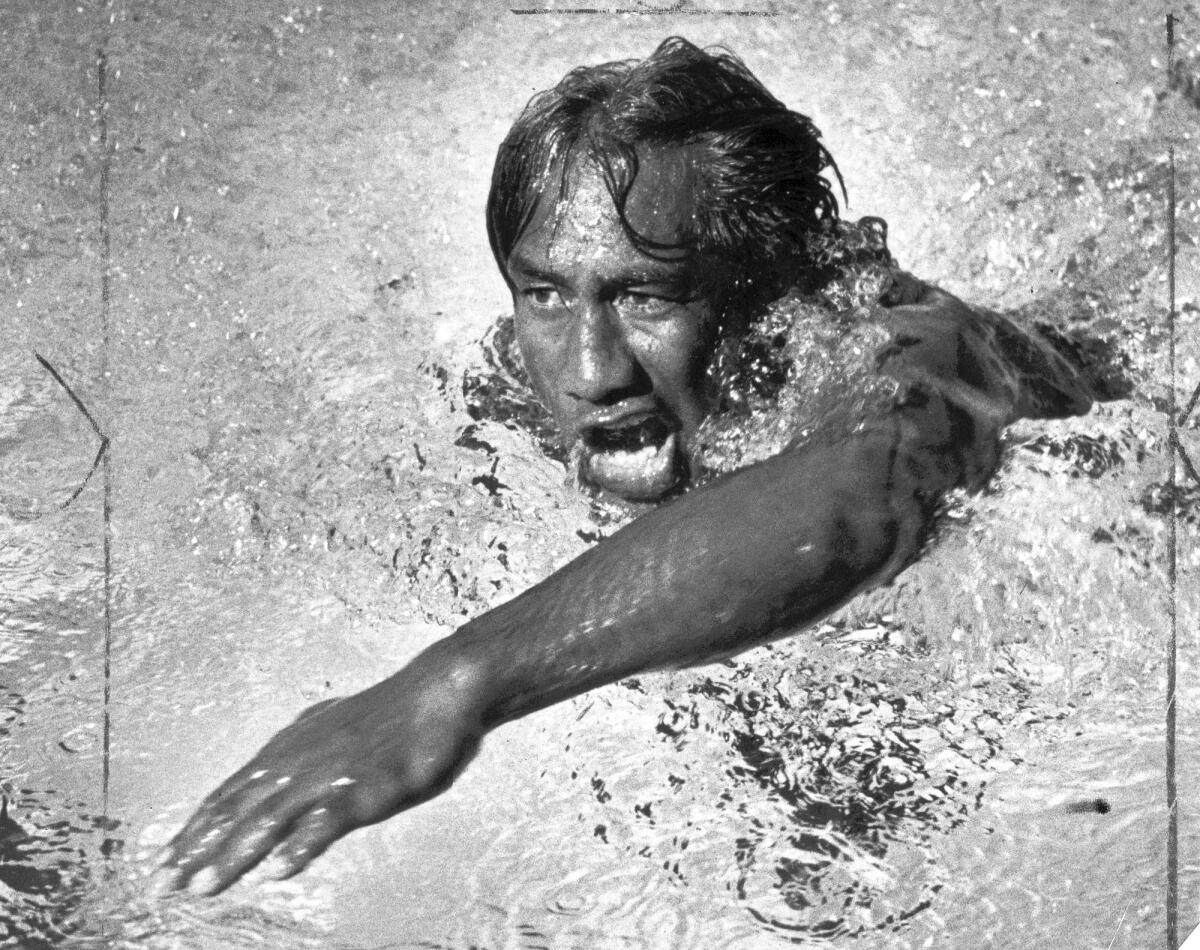Heroic efforts of âDukeâ off Corona del Mar remembered

It was in the turbulent Pacific waters off Corona del Mar 90 years ago when Duke Kahanamoku, the celebrated Hawaiian surfing and Olympic swimming titleholder, proved once again to be a genuine American champion.
Dawn was breaking that Sunday, June 14, 1925, when Kahanamoku, then 35, in the company of several surfers, including Gerard âJerryâ Vultee, his best friend and pioneer aircraft designer, was preparing to enter the waves on his 12-foot mahogany surfboard.
The âDukeâ (who was born 125 years ago this month) could see that trouble was brewing when massive waves and swells propelled by fierce winds began to lash the coast.
All of a sudden, one of his companions cried out, âThat boat is in trouble,â pointing to the 40-foot, 5-ton yacht Thelma attempting to enter Newport Harbor through the churning breakers.
Coastal storms had come up suddenly during previous months, and just recently they had brought havoc and death to the very waters Kahanamoku and his friends were planning to surf.
A year earlier, on June 8, 1924, the 30-foot fishing boat Adieu, carrying 16 passengers and its captain, overturned during a storm off Corona del Mar, drowning five fishermen from Santa Ana. On May 21, 1925 â just three weeks before the Thelmaâs foundering â a rowboat carrying three teenagers capsized in heavy waves. Two of the youths made it to shore; a third drowned.
So the fears of Kahanamoku mounted as he observed the hapless Thelma struggle to stay afloat.
âOnly a porpoise or a sea lion had the right to be out there ...â he later recalled, according to old news stories. âFrom the shore we saw the Thelma wallowing in the water just seaward of where the breakers were falling. You could see her rails crowded with fishermen. She appeared to be trying to fight her way toward safe water ... but it obviously was a losing battle.
âA mountain of solid green water curled down upon the vessel ... spume geysered up in all directions ... then before the next mammoth breaker could blot out the view again, it was obvious the Thelma had capsized and thrown her passengers into the boiling sea.â
The following day, in a dramatic Page One story headlined, âFive Are Drowned When Waves Capsize Yacht ... Twelve More Narrowily Escape As Swimmers Bring Victims to Shore on Surf Boards,â the Los Angeles Times described the frightening scene.
âThe swell, as it gained momentum, merged into a mountainous wave and crashed over the bow, smashing the plate glass window of the engine-room, flooding the compartment and stopping the engine,â according to the article. âPractically all the members of the pleasure party were swept overboard with the first wave and were struggling in the midst of the torn wreckage and pounding waves.
âBefore the fisherman could put on life preservers and assistance could reach them, the boat was caught broadside in the teeth of the tremendous breakers and rolled completely over twice.â
The sinking, said the newspaper, âresulted in the drowning of five passengers. Twelve others were pulled from the sea in a spectacular rescue staged by Duke Kahanamoku, famous Hawaiian swimmer and others who braved the heavy seas on surfboards.â
In another first-person description of his role during the Thelma tragedy, Kahanamoku was quoted in a Honolulu newspaper several weeks later as stating, âNeither I or my pals were thinking heroics ... we were simply running ... me with my board and the others to get their boards ... and hoping to save lives. I hit the water very hard and with all the forward thrust I could generate I paddled until my arms begged for mercy.
âI reached the screaming and gagging victims and began grabbing at their frantic arms and legs. I brought one victim in on my board, then two on another trip, and possibly three on a third trip. Some victims we could not save at all, for they went under before we could get to them. Without the boards, we would probably not have been able to get to them.â
Witnesses at the time said Kahanamoku said was the first rescuer to reach the scene.
Of the 17 aboard the Thelma, Kahanamoku is credited with saving eight, each of whom were taken to area hospitals with serious injuries that included broken arms and legs. Two of his friends saved the other four who also were hospitalized.
The five fisherman who died were from Riverside.
Then-Newport Beach Police Chief Jim Porter told The Times, âKahanamokuâs performance was the most superhuman rescue act and the finest display of surfboard riding that has ever been seen in the world. Many more would have drowned but for the quick work of the Hawaiian swimmer.â
Kahanamoku, who had won countless surfing trophies and five Olympic medals in swimming (three gold, two silver, one bronze) between 1912 and 1922, received international acclaim for his heroics at the Corona del Mar tragedy, and was given the nicknames âThe Great American Heroâ and âThe Great Human Fish.â
He appeared in 15 feature motion pictures, playing such roles as Indian chief, lifeguard, Turkish sultan and wild animal trainer. He played himself in two documentaries.
A long-time friend of another âDuke,â actor John Wayne, Kahanamoku appeared with Wayne in the 1948 movie âWake of the Wild Witch,â playing the role of Ua Nuke, the native chief of a South Pacific island. He also played the part of a native chief named Duke Kahanamoku in the 1955 film âMister Robertsâ that starred Jack Lemon, Henry Fonda, James Cagney and William Powell.
--------------------------
For the record: An earlier version of this story incorrectly referred to a John Wayne movie as âWake of the Wild Witch.â The correct title is âWake of the Red Witch.â
--------------------------
Kahanamoku, who served as sheriff of Honolulu for 12 years and married, for the first time, at the age of 40, succumbed to a heart attack in Honolulu at the age of 77 on Jan. 22, 1968. Following a church service, his ashes were scattered in the Pacific off Honolulu.
Statues of Kahanamoku have been erected in downtown Huntington Beach, at the corner of Main St. and Pacific Coast Highway, and on Waikiki Beach in Honolulu. And he has been inducted into the Huntington Beach Surfersâ Hall of Fame, the International Surfing Hall of Fame and the U.S. Olympic Hall of Fame. A U.S. postage stamp bearing his name and likeness was issued in 2002.
As for Jerry Vultee, Kahanamokuâs best friend and long-time surfing companion who joined in the rescue of the Thelma fishermen, Cal Tech alumnus and founder of the Vultee Aircraft Corp. that built the Armyâs iconic V-ll dive bomber:
On Jan. 29, 1938 â 13 years after the Thelma tragedy â Vultee was piloting a small, single-engine airplane while en route from New York City to Los Angeles when heavy snows and winds forced it off course following a stop for fuel at Winslow, Ariz.
Attempting to land on the snow-covered desert, Vultee lost his bearings and crashed into a tree near Sedona. A nearby resident said he heard âan awful screech ... then deafening silence ... and then a loud bang.â
It took rescuers a day to reach the wreckage of the tiny Stinson SR-9C aircraft that contained the remains of Vultee, 38, and his sole passenger, his wife, Sylvia, 27. The couple had left their only child, 6-month old Peter, in the care of a nurse at their home in Los Angeles.
Contributor David C. Henley is a resident of Newport Beach, a longtime foreign correspondent and a member of the Board of Trustees of Chapman University.
More to Read
Sign up for Essential California
The most important California stories and recommendations in your inbox every morning.
You may occasionally receive promotional content from the Los Angeles Times.









